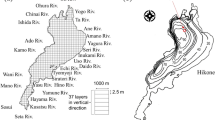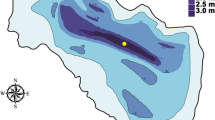Abstract
Long-term (1987–2015) monitoring data from Lake Lugano (Switzerland/Italy) were used to examine the effects of winter weather, solar radiation and mixing regime on the recovery of the trophic state of a lake undergoing nutrient management. Main hypotheses were that (H1) trends in trophic state were influenced not only by nutrient management, but also by winter weather and solar radiation, and (H2) the effects of management were more pronounced in the holomictic South basin than in the meromictic North basin of the lake. External loadings of phosphorus were strongly reduced during the study period, but key indicators of trophic state, including phosphorous concentration, primary production, chlorophyll a and deep-water oxygenation, showed inconsistent responses. Supporting H1, winter weather (parameterized using an index of the East Atlantic pattern) influenced temporal variation in phosphorus concentration and primary production in the North basin. Supporting H2, the effects of management on trophic state were clearer in the South basin, where most trophic-state indicators declined. Meromixis affected the restoration of the North basin lake by transmitting effects of climatic variation on trophic state. The added variability obscured the effects of restoration and caused sudden deteriorations in water quality, indicating that the restoration of meromictic lakes presents unique challenges.





Similar content being viewed by others
References
Adrian, R., C. M. O’Reilly, H. Zagarese, S. B. Baines, D. O. Hessen, W. Keller, D. M. Livingstone, R. Sommaruga, D. Straile, E. Van Donk & G. A. Weyhenmeyer, 2009. Lakes as sentinels of climate change. Limnolology and Oceanography 54: 2283–2297.
Barbieri, A. & R. Mosello, 1992. Chemistry and trophic evolution of Lake Lugano in relation to nutrient budget. Aquatic Sciences 54: 219–237.
Çamdevýren, H., N. Demýr, A. Kanik & S. Keskýn, 2005. Use of principal component scores in multiple linear regression models for prediction of Chlorophyll-a in reservoirs. Ecological Modelling 181: 581–589.
Carlson, R. E., 1977. A trophic state index for lakes. Limnology and Oceanography 22: 361–369.
Cohen, J., 1988. Statistical Power Analysis for the Behavioral Sciences, 2nd ed. L. Erlbaum Associates, Hillsdale.
Dillon, P. J. & F. H. Rigler, 1975. A simple method for predicting the capacity of a lake for development based on lake trophic status. Journal of the Fisheries Board of Canada 32: 1519–1531.
D.A., Dipartimento Ambiente [del Cantone Ticino], 1982. Il Lago Ceresio. Stato delle sue acque, obiettivi, misure d’intervento. [Lake Lugano: State of its waters, restoration schemes and goals]. Bellinzona: 85.
Edmondson, W. T. & J. T. Lehman, 1981. The effect of changes in the nutrient income on the condition of Lake Washington. Limnology and Oceanography 26: 1–29.
Franchini, F., F. Lepori & A. Bruder, 2017. Improving estimates of primary production in lakes: a test and a case study from a peri-alpine lake (Lake Lugano). Inland Waters 7: 77–87.
Gächter, R. & B. Wehrli, 1998. Ten years of artificial mixing and oxygenation: no effect on the internal phosphorus loading of two eutrophic lakes. Environmental Science and Technology 32: 3659–3665.
Gulati, R. D., L. M. D. Pires & E. Van Donk, 2008. Lake restoration studies: failures, bottlenecks and prospects of new ecotechnological measures. Limnologica-Ecology and Management of Inland Waters 38: 233–247.
Gulati, R. D., E. Zadereev & A. G. Degermendzhi (eds), 2017. Ecology of Meromictic Lakes. Springer International Publishing, New York.
Healey, F. P. & L. L. Hendzel, 1980. Physiological indicators of nutrient deficiency in lake phytoplankton. Canadian Journal of Fisheries and Aquatic Sciences 37: 442–453.
Holzner, C. P., W. Aeschbach-Hertig, M. Simona, M. Veronesi, D. M. Imboden & R. Kipfer, 2009. Exceptional mixing events in meromictic Lake Lugano (Switzerland/Italy), studied using environmental tracers. Limnology & Oceanography 54: 1113–1124.
Imboden, D. M., 1992. Possibilities and limitations of lake restoration: conclusions for Lake Lugano. Aquatic Sciences-Research Across Boundaries 54: 381–390.
Jeppesen, E., M. Søndergaard, J. P. Jensen, K. E. Havens, O. Anneville, L. Carvalho, M. F. Coveney, R. Deneke, M. T. Dokulil, B. O. B. Foy & D. Gerdeaux, 2005. Lake responses to reduced nutrient loading–an analysis of contemporary long-term data from 35 case studies. Freshwater Biology 50: 1747–1771.
Kirillin, G., 2010. Modeling the impact of global warming on water temperature and seasonal mixing regimes in small temperate lakes. Boreal Environment Research 15: 279–293.
Lehman, J. T., R. Mugidde & D. A. Lehman, 1998. Lake Victoria Plankton Ecology: mixing depth and climate-driven control of lake condition. In Lehman, J. T. (ed.), Environmental Change and Response in East African Lakes., Monographiae Biologicae 79 Springer, Dordrecht: 99–116.
Lehmann, M. F., M. Simona, S. Wyss, J. Blees, C. H. Frame, H. Niemann, M. Veronesi & J. Zopfi, 2015. Powering up the “biogeochemical engine”: the impact of exceptional ventilation of a deep meromictic lake on the lacustrine redox, nutrient, and methane balances. Frontiers in Earth Science 3: 45.
Lepori, F. & J. J. Roberts, 2015. Past and future warming of a deep European lake (Lake Lugano): what are the climatic drivers? Journal of Great Lakes Research 41: 973–981.
Lepori, F. & J. J. Roberts, 2017. Effects of internal phosphorus loadings and food-web structure on the recovery of a deep lake from eutrophication. Journal of Great Lakes Research 43: 255–264.
Lepori, F., J.J. Roberts & T.S. Schmidt, 2018. A paradox of warming in a deep perialpine lake (Lake Lugano, Switzerland and Italy). Hydrobiologia.
Liboriussen, L., M. Søndergaard, E. Jeppesen, I. Thorsgaard, S. Grünfeld, T. S. Jakobsen & K. Hansen, 2009. Effects of hypolimnetic oxygenation on water quality: results from five Danish lakes. Hydrobiologia 625: 157–172.
Marshall, B., C. Ezekiel, J. Gichuki, O. Mkumbo, L. Sitoki & F. Wanda, 2009. Global warming is reducing thermal stability and mitigating the effects of eutrophication in Lake Victoria (East Africa). Available from Nature Precedings. http://hdl.handle.net/10101/npre.2009.3726.1.
Matzinger, A., B. Müller, P. Niederhauser, M. Schmid & A. Wüest, 2010. Hypolimnetic oxygen consumption by sediment-based reduced substances in former eutrophic lakes. Limnology and Oceanography 55(5): 2073–2084.
McCrackin, M. L., H. P. Jones, P. C. Jones & D. Moreno-Mateos, 2017. Recovery of lakes and coastal marine ecosystems from eutrophication: a global meta-analysis. Limnology and Oceanography 62: 507–518.
Mosello, R., W. Ambrosetti, S. Arisci, R. Bettinetti, F. Buzzi, A. Calderoni, E. Carrara, R. De Bernardi, S. Galassi, L. Garibaldi, B. Leoni, M. Manca, A. Marchetto, G. Morabito, A. Oggioni, R. Pagnotta, D. Ricci, M. Rogora, N. Salmaso, M. Simona, G. Tartari, M. Veronesi & P. Volta, 2010. Evoluzione recente della qualità delle acque dei laghi profondi sudalpini (Maggiore, Lugano, Como, Iseo e Garda) in risposta alle pressioni antropiche e alle variazioni climatiche. Biologia Ambientale 24: 167–177.
Moss, B., S. Kosten, M. Meerhof, R. Battarbee, E. Jeppesen, N. Mazzeo, K. Havens, G. Lacerot, Z. Liu, L. De Meester & H. Paerl, 2011. Allied attack: climate change and eutrophication. Inland Waters 1: 101–105.
Nürnberg, G. K. & R. H. Peters, 1984. The importance of internal phosphorus load to the eutrophication of lakes with anoxic hypolimnia. Verhandlungen der Internationalen Vereinigung für Theoretische und Angewandte Limnologie 22: 190–194.
OECD (Organization for Economic Cooperation and Development), 1982. Eutrophication of waters: monitoring, assessment and control. Organisation for Economic and Cooperative Development, Paris.
Pareeth, S., M. Bresciani, F. Buzzi, B. Leoni, F. Lepori, A. Ludovisi, G. Morabito, R. Adrian, M. Neteler & N. Salmaso, 2016. Warming trends of perialpine lakes from homogenised time series of historical satellite and in situ data. Science of The Total Environment 578: 417–426.
Posch, T., O. Köster, M. M. Salcher & J. Pernthaler, 2012. Harmful filamentous cyanobacteria favoured by reduced water turnover with lake warming. Nature Climate Change 2: 809–813.
Rand, M. C., A. E. Greenberg & M. J. Taras, 1975. Standard methods for the examination of water and wastewater, 14th ed. American Public Health Association, American Water Works Association and Water Control Federation, New York.
Salmaso, N., 2012. Influence of atmospheric modes of variability on a deep lake south of the Alps. Climate Research 51: 125–133.
Salmaso, N., F. Buzzi, L. Cerasino, L. Garibaldi, B. Leoni, G. Morabito, M. Rogora & M. Simona, 2013. Influence of atmospheric modes of variability on the limnological characteristics of large lakes south of the Alps: a new emerging paradigm. Hydrobiologia 731: 31–48.
Sanchez-Lorenzo, A. & M. Wild, 2012. Decadal variations in estimated surface solar radiation over Switzerland since the late 19th century. Atmospheric Chemistry and Physics 12: 8635–8644.
Sarr, D. A., 2002. Riparian livestock exclosure research in the western United States: a critique and some recommendations. Environmental Management 30: 516–526.
Schindler, D. W., 1977. Evolution of phosphorus limitation in lakes. Science 195: 260–262.
Schindler, D. W., S. R. Carpenter, S. C. Chapra, R. E. Hecky & D. M. Orihel, 2016. Reducing phosphorus to curb lake eutrophication is a success. Environmental Science & Technology 50: 8923–8929.
Schmid, M. & O. Köster, 2016. Excess warming of a Central European lake driven by solar brightening. Water Resources Research 52: 8103–8116.
Smith, V. H., 2003. Eutrophication of freshwater and coastal marine ecosystems a global problem. Environmental Science and Pollution Research 10: 126–139.
Smith, V. H., G. D. Tilman & J. C. Nekola, 1999. Eutrophication: impacts of excess nutrient inputs on freshwater, marine, and terrestrial ecosystems. Environmental Pollution 100: 179–196.
Straile, D., K. Jöhnk & R. Henno, 2003. Complex effects of winter warming on the physicochemical characteristics of a deep lake. Limnology and oceanography 48: 1432–1438.
Søndergaard, M., P. J. Jensen & E. Jeppesen, 2001. Retention and internal loading of phosphorus in shallow, eutrophic lakes. The Scientific World Journal 1: 427–442.
Ufficio Protezione e Depurazione Acque (UPDA), 2007. Ricerche sull’evoluzione del Lago di Lugano. Aspetti limnologici. Programma quinquennale 2003–2007. Campagna 2006. Commissione Internazionale per la Protezione delle Acque Italo-Svizzere (Ed.); Torino, Italy.
Ufficio Protezione e Depurazione Acque (UPDA), 2008. Ricerche sull’evoluzione del Lago di Lugano. Aspetti limnologici. Programma quinquennale 2003-2007. Campagna 2007 e rapporto quinquennale 2003-2007. Commissione Internazionale per la Protezione delle Acque Italo-Svizzere (Ed.); Torino, Italy.
Vanni, M. J., J. S. Andrews, W. H. Renwick, M. J. Gonzalez & S. J. Noble, 2006. Nutrient and light limitation of reservoir phytoplankton in relation to storm-mediated pulses in stream discharge. Archiv für Hydrobiologie 167: 421–445.
Verburg, P., R. E. Hecky & H. Kling, 2003. Ecological consequences of a century of warming in Lake Tanganyika. Science 31: 505–507.
Vollenweider, R. A., 1968. Scientific fundamentals of the eutrophication of lakes and flowing waters, with particular reference to nitrogen and phosphorous as factors in eutrophication. Organisation for Economic Cooperation and Development, Paris: 159.
Wagner, C. & R. Adrian, 2009. Cyanobacteria dominance: quantifying the effects of climate change. Limnology and Oceanography 54: 2460–2468.
Winder, M., 2012. Limnology: lake warming mimics fertilization. Nature Climate Change 2: 771–772.
Wright, S., 1934. The method of path coefficients. Annals of Mathematical Statistics 5: 161–215.
Acknowledgements
We thank all staff involved in the monitoring programme of Lake Lugano since the beginning of the study period and the Editors of this special issue for providing an opportunity to present our work. Nico Salmaso kindly provided the updated series of the index of the East Atlantic pattern. MB was supported from Swiss National Science Foundation Grant for Research (169552).
Author information
Authors and Affiliations
Corresponding author
Additional information
Guest editors: Nico Salmaso, Orlane Anneville, Dietmar Straile & Pierluigi Viaroli / Large and deep perialpine lakes: ecological functions and resource management
Rights and permissions
About this article
Cite this article
Lepori, F., Bartosiewicz, M., Simona, M. et al. Effects of winter weather and mixing regime on the restoration of a deep perialpine lake (Lake Lugano, Switzerland and Italy). Hydrobiologia 824, 229–242 (2018). https://doi.org/10.1007/s10750-018-3575-2
Received:
Revised:
Accepted:
Published:
Issue Date:
DOI: https://doi.org/10.1007/s10750-018-3575-2




